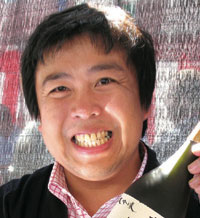How to describe sake during sake tasting
During a sake tasting, the appearance, aroma, and flavor of the sake are described. Let’s check how each of these key points are described.
[Appearance]
Describe the transparency, clarity, and color of the sake. If clear, describe the sake as bright. If glossy, describe the sake as “mellow with glaze.” Describe the color of sake as “golden brown” or “bright yellow” in Japanese terms or use English terms such as “yellow” or “gold” used internationally.
The color of sake is sometimes compared to gemstones, such as “topaz.” Add the shade to the color to describe the appearance and impression of the sake.
Describe the transparency, clarity, and color of the sake. If clear, describe the sake as bright. If glossy, describe the sake as “mellow with glaze.” Describe the color of sake as “golden brown” or “bright yellow” in Japanese terms or use English terms such as “yellow” or “gold” used internationally.
The color of sake is sometimes compared to gemstones, such as “topaz.” Add the shade to the color to describe the appearance and impression of the sake.
[Aroma]
Describe the sake aroma as “Top note” or “After flavor.” Sake aroma is broadly classified into four types - “splendid,” “refreshing,” “gentle,” or “fullness.” Splendid sake aroma refers to the aroma of ripe fruits or a strong floral fragrance, while refreshing refers to the aroma of herbs or citrus fruits. Gentle aroma refers to bitter vegetables or nuts, while fullness refers to the aroma of spices or dairy products. Sake aroma is quite complex, thus multiple terms are often used to describe the sake aroma.
Describe the sake aroma as “Top note” or “After flavor.” Sake aroma is broadly classified into four types - “splendid,” “refreshing,” “gentle,” or “fullness.” Splendid sake aroma refers to the aroma of ripe fruits or a strong floral fragrance, while refreshing refers to the aroma of herbs or citrus fruits. Gentle aroma refers to bitter vegetables or nuts, while fullness refers to the aroma of spices or dairy products. Sake aroma is quite complex, thus multiple terms are often used to describe the sake aroma.
日本酒をテイスティングするときの表現方法
日本酒をテイスティングするときは、外観、香り、味わいを言葉で表現します。それぞれの表現方法をいくつか確認しましょう。
【外観】
透明度や輝き、色合いなどを表現します。透き通っている場合は「冴え」、艶がある場合は「照り」、少し濁っている場合は「ぼけ」などの言葉を使います。色合いは「黄金色」「山吹色」といった和名を使うこともあれば、国際的に通用する「イエロー」や「ゴールド」などの言葉で表現することもあります。また、「トパーズ」など宝石にたとえることもあります。これら色の表現に、濃淡を加えて外観の印象を表しましょう。
透明度や輝き、色合いなどを表現します。透き通っている場合は「冴え」、艶がある場合は「照り」、少し濁っている場合は「ぼけ」などの言葉を使います。色合いは「黄金色」「山吹色」といった和名を使うこともあれば、国際的に通用する「イエロー」や「ゴールド」などの言葉で表現することもあります。また、「トパーズ」など宝石にたとえることもあります。これら色の表現に、濃淡を加えて外観の印象を表しましょう。
【香り】
「上立ち香」と「含み香」を表現します。香りの種類を大きく分けると、「華やか」「爽やか」「穏やか」「ふくよか」の4つ。華やかな香りは熟した果物や香りの強い花など、爽やかな香りはハーブや酸味のある果物など、穏やかな香りは苦味のある野菜やナッツなど、ふくよかな香りはスパイスや乳製品などにたとえられます。なお、日本酒の香りは複雑なため、複数の香りを織り交ぜて表すことも多くあります。
「上立ち香」と「含み香」を表現します。香りの種類を大きく分けると、「華やか」「爽やか」「穏やか」「ふくよか」の4つ。華やかな香りは熟した果物や香りの強い花など、爽やかな香りはハーブや酸味のある果物など、穏やかな香りは苦味のある野菜やナッツなど、ふくよかな香りはスパイスや乳製品などにたとえられます。なお、日本酒の香りは複雑なため、複数の香りを織り交ぜて表すことも多くあります。
Cómo describir el sake durante una cata
Durante una cata de sake, se describe el aspecto, el aroma y el sabor del sake. Veamos cómo se describe cada uno de estos puntos claves.
[Aspecto]
Expresa transparencia, brillo, color, etc. Si está claro, utilizamos palabras como "sae" (claro), si está brillante, utilizamos palabras como "eri" (lustroso), y si está ligeramente turbio, utilizamos palabras como "boke" (borroso). El color se puede describir utilizando nombres japoneses como "amarillo dorado" o "amarillo", o se puede describir con palabras aceptadas internacionalmente como "amarillo" u "oro". A veces también se compara con piedras preciosas como el "topacio". Añade matices a estos colores para crear la impresión del exterior.
[Aroma]
Expresa el "aroma superior" y el "aroma inferior". Las fragancias se pueden dividir en cuatro tipos: hermosas, refrescantes, suaves y con cuerpo. Los aromas florales se asemejan a frutas maduras o flores fuertemente perfumadas, los aromas refrescantes a hierbas y frutas ácidas, los aromas suaves a verduras amargas y nueces, y los aromas ricos a especias y productos lácteos. El aroma del sake es bastante complejo, por lo que a menudo se utilizan múltiples términos para describirlo.
Durante una cata de sake, se describe el aspecto, el aroma y el sabor del sake. Veamos cómo se describe cada uno de estos puntos claves.
[Aspecto]
Expresa transparencia, brillo, color, etc. Si está claro, utilizamos palabras como "sae" (claro), si está brillante, utilizamos palabras como "eri" (lustroso), y si está ligeramente turbio, utilizamos palabras como "boke" (borroso). El color se puede describir utilizando nombres japoneses como "amarillo dorado" o "amarillo", o se puede describir con palabras aceptadas internacionalmente como "amarillo" u "oro". A veces también se compara con piedras preciosas como el "topacio". Añade matices a estos colores para crear la impresión del exterior.
[Aroma]
Expresa el "aroma superior" y el "aroma inferior". Las fragancias se pueden dividir en cuatro tipos: hermosas, refrescantes, suaves y con cuerpo. Los aromas florales se asemejan a frutas maduras o flores fuertemente perfumadas, los aromas refrescantes a hierbas y frutas ácidas, los aromas suaves a verduras amargas y nueces, y los aromas ricos a especias y productos lácteos. El aroma del sake es bastante complejo, por lo que a menudo se utilizan múltiples términos para describirlo.




